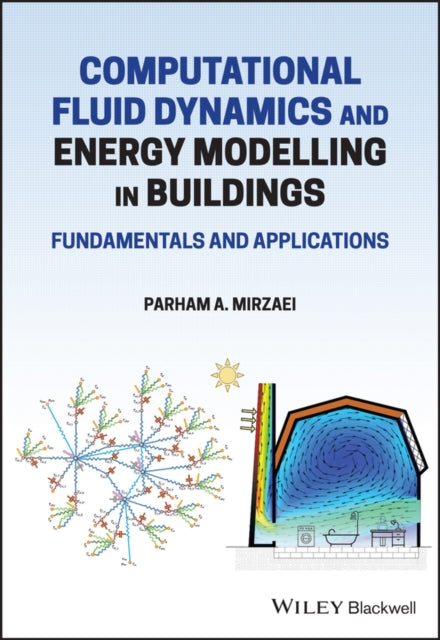PA Mirzaei
Computational Fluid Dynamics and Energy Modelling in Buildings - Fundamentals and Applications
Computational Fluid Dynamics and Energy Modelling in Buildings - Fundamentals and Applications
YOU SAVE £6.45
- Condition: Brand new
- UK Delivery times: Usually arrives within 2 - 3 working days
- UK Shipping: Fee starts at £2.39. Subject to product weight & dimension
Bulk ordering. Want 15 or more copies? Get a personalised quote and bigger discounts. Learn more about bulk orders.
Couldn't load pickup availability
- More about Computational Fluid Dynamics and Energy Modelling in Buildings - Fundamentals and Applications
Computational Fluid Dynamics and Energy Modelling in Buildings provides a comprehensive overview of the fundamentals of heat and mass transport simulation and energy performance in buildings. It explains the basics of fluid mechanics, thermodynamics, and heat transfer, and how they can be used to model energy flow in buildings. It also introduces computational fluid dynamics (CFD) as a detailed modelling technique for airflow in buildings. The book is tailored for audiences without extensive past experience of numerical methods and can be used by undergraduate or graduate students in architecture, urban planning, geography, architectural engineering, and other engineering fields, along with building performance and simulation professionals.
Format: Paperback / softback
Length: 624 pages
Publication date: 24 November 2022
Publisher: John Wiley and Sons Ltd
Computational Fluid Dynamics and Energy Modelling in Buildings: Fundamentals and Applications
A Comprehensive Overview of the Fundamentals of Heat and Mass Transport Simulation and Energy Performance in Buildings
In the first part of Computational Fluid Dynamics and Energy Modelling in Buildings: Fundamentals and Applications, the author delves into the intricate realm of fluid mechanics, thermodynamics, and heat transfer, with a particular emphasis on their application in buildings. This foundational knowledge serves as the backdrop for further exploring the modeling of heat and mass transport within buildings, elucidating commonly employed simplifications and assumptions.
In the second part, the author expands on the principles elucidated in part 1, elucidating how they can be employed to model energy flow within buildings, which forms the cornerstone of all commercial and educational building energy simulation tools. An innovative illustrative nodal network concept is introduced to facilitate a deeper understanding of the principles of conservation laws in buildings. The application of numerical techniques to develop dynamic simulation tools is then explored. In essence, grasping these techniques empowers readers to make informed choices when utilizing building energy simulation tools, rather than relying on default settings.
Detailed airflow information in buildings cannot be obtained through traditional building energy simulation techniques. Consequently, part three is dedicated to introducing computational fluid dynamics (CFD) as a comprehensive modeling technique for airflow within buildings. This part commences with an introduction to the fundamentals of the finite volume method employed to solve the governing fluid equations, along with the associated challenges and considerations. The final chapter of this part addresses the solutions to some practical problems of airflow within and around buildings.
In conclusion, Computational Fluid Dynamics and Energy Modelling in Buildings: Fundamentals and Applications provides a comprehensive and in-depth exploration of the fundamental principles of heat and mass transport simulation and energy performance in buildings. By delving into the realms of fluid mechanics, thermodynamics, and heat transfer, the book equips readers with the knowledge and tools necessary to model and analyze energy flow within buildings, enabling them to make informed decisions that promote sustainable and efficient design practices.
Weight: 940g
Dimension: 250 x 168 x 32 (mm)
ISBN-13: 9781119743514
This item can be found in:
UK and International shipping information
UK and International shipping information
UK Delivery and returns information:
- Delivery within 2 - 3 days when ordering in the UK.
- Shipping fee for UK customers from £2.39. Fully tracked shipping service available.
- Returns policy: Return within 30 days of receipt for full refund.
International deliveries:
Shulph Ink now ships to Australia, Belgium, Canada, France, Germany, Ireland, Italy, India, Luxembourg Saudi Arabia, Singapore, Spain, Netherlands, New Zealand, United Arab Emirates, United States of America.
- Delivery times: within 5 - 10 days for international orders.
- Shipping fee: charges vary for overseas orders. Only tracked services are available for most international orders. Some countries have untracked shipping options.
- Customs charges: If ordering to addresses outside the United Kingdom, you may or may not incur additional customs and duties fees during local delivery.


